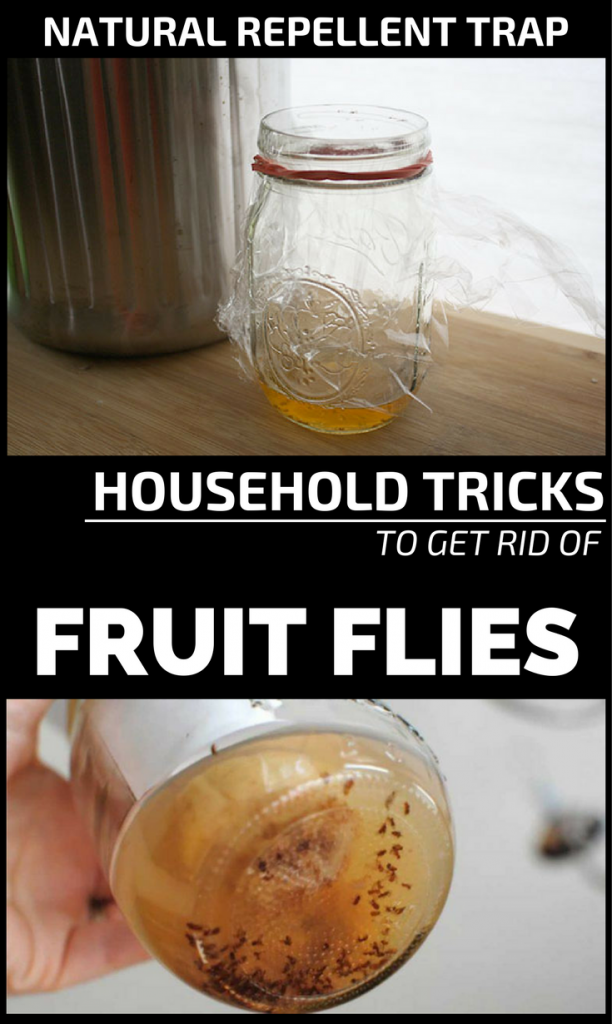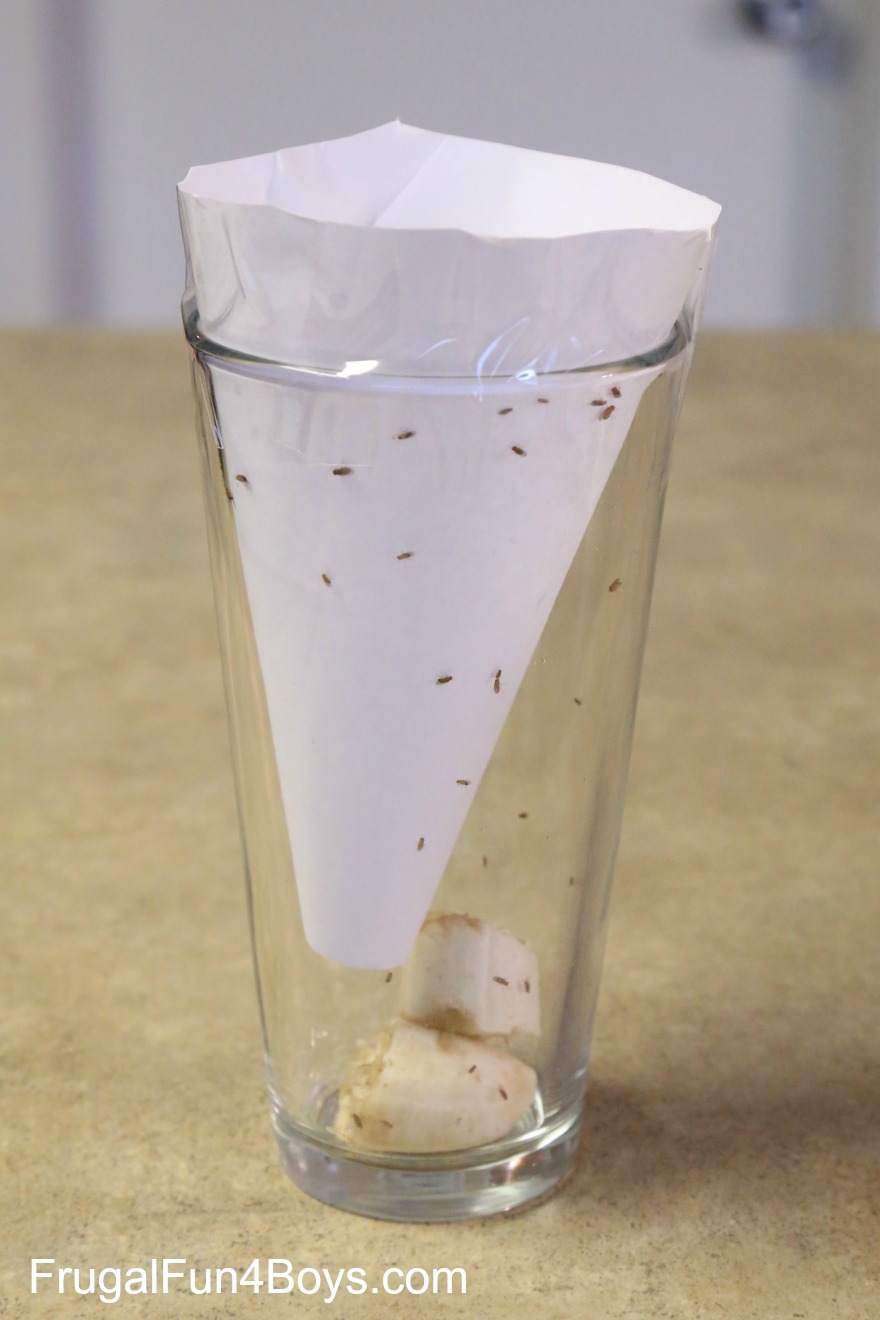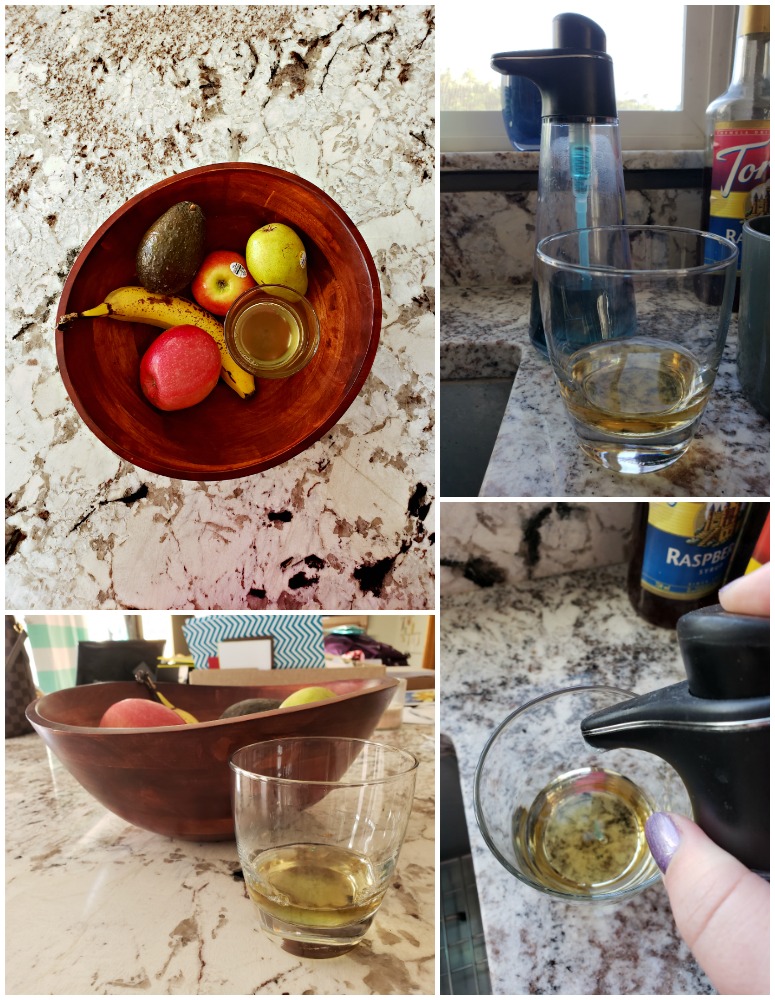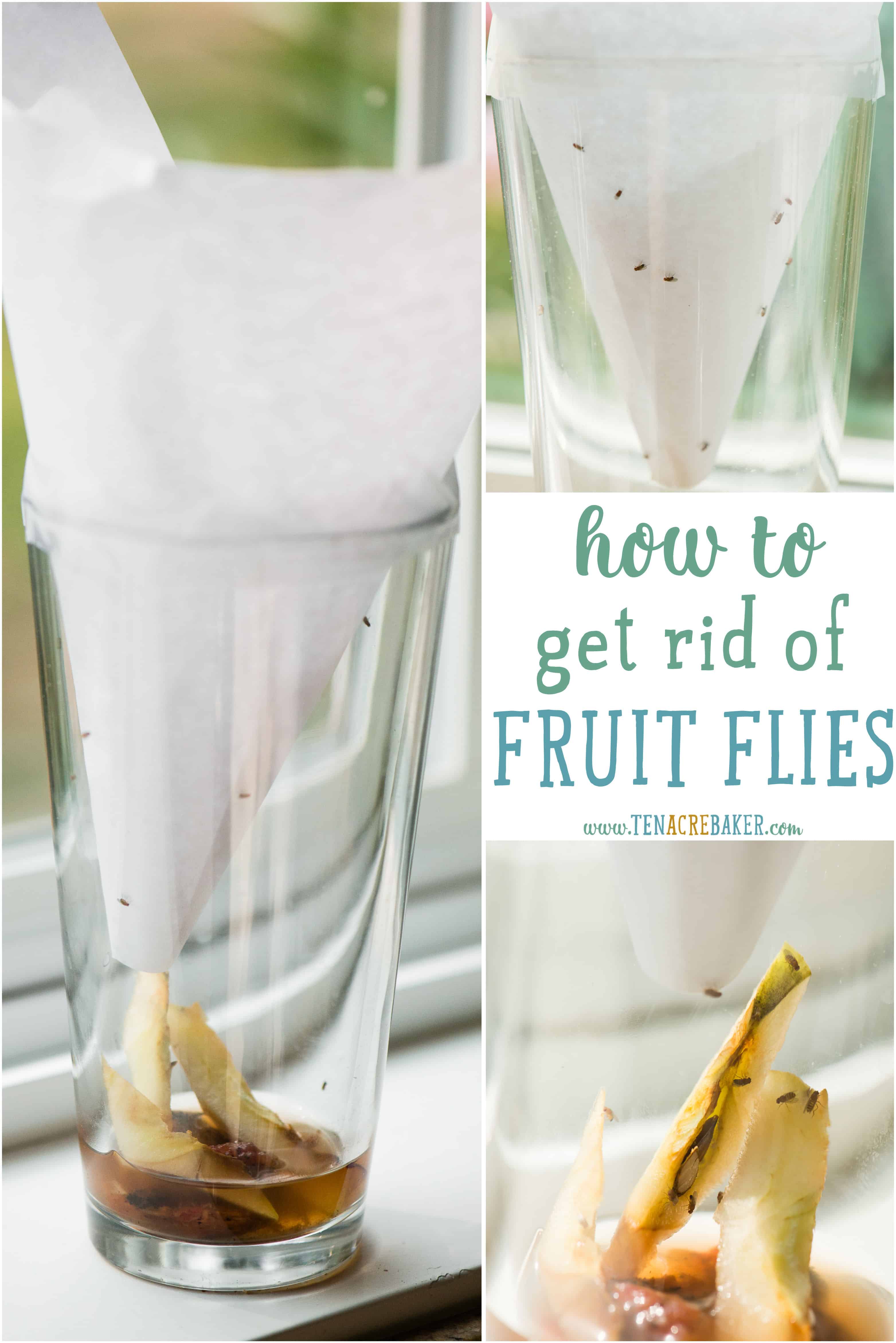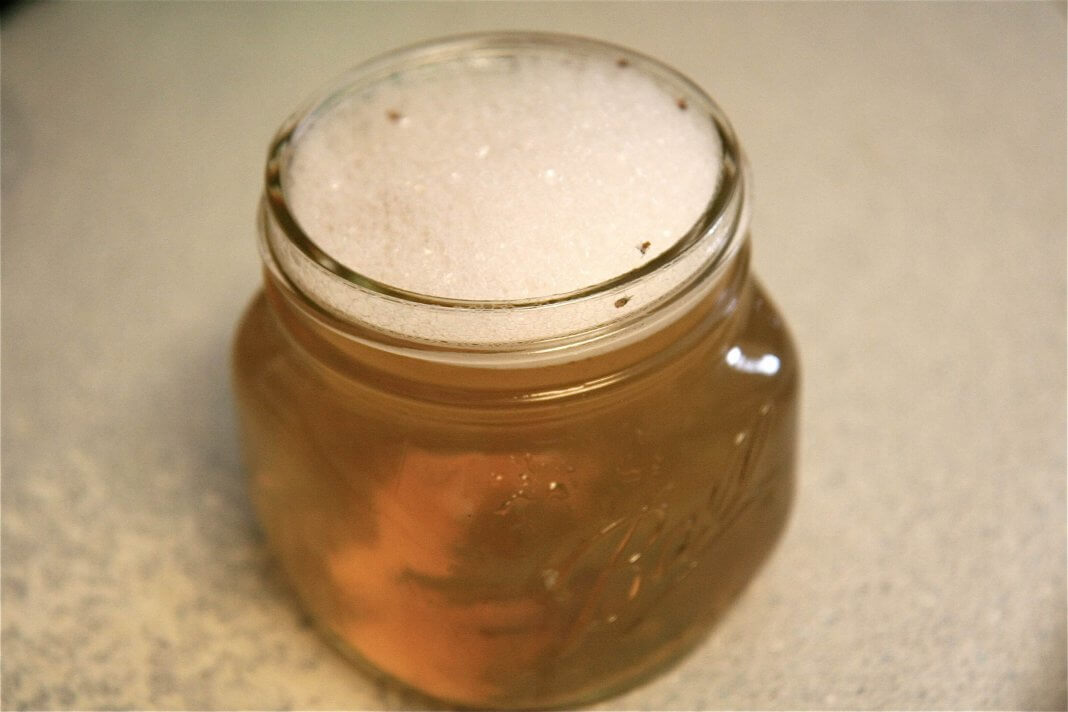Instead of relying on homemade traps, it's better to locate and remove the source of the fruit fly infestation. Though it may seem wasteful, the best wa y to ensure you eliminate any potential breeding sites is to discard ripe or rotting produce where fruit flies may have laid their eggs. Seal this produce in a plastic bag and place it in an outdoor t rash can. Next, make sure all indoor trash cans are emptied routinely and are free of leftover food and residues. Wipe down the trash cans with soap and warm water to remove any sweet, sticky substanc es from the surface.
One of the most common recommendations for trapping and killing fruit flies is to create a DIY trap made by combining a small amount of apple cider vinegar with a few drops of dish soap. Researchers from the University of Maryland recommend using a commercial fru it fly trap to capture adults or to make your own. To make this trap, "fill glass jar with a small amount of apple cider vinegar and pour a few drops of dish soap over the surface". Then, cover the glass jar with plastic wrap and poke small holes throughout the covering.
To begin to inspect where fruit fly infestations come from, look first for fruit fly sources in areas where vegetables or fruits are stored outside refrigeration. Also, look for fruit fly sources in garbage cans, under appliances, and recycling bins. Even a little-spilled juice behind an appliance can contribute to their breeding. When searching for fruit fly breeding sources, remember that the larva can only survive in decaying organic matter that is moist. All fruit fly infestations' stages depend on the organic debris to complete the complete fruit fly cycle. Whenever possible, food and materials on which fruit flies can lay their eggs must be removed.
The key to preventing a fruit fly infestation is to eliminate any potential breeding grounds. "Fruit fly eggs may already be present on fruit or vegetables that are brought home from the grocery store," explains Fredericks. "Also, remove kitchen trash daily and keep garbage and recycling bins clean," he says. The other kitchen fruit fly solution is to trap them.
There are several traps that you can construct on your own from readily available materials. The majority of these involve placing some form of bait in a bowl or glass. The bait can be a piece of fruit, apple cider vinegar, yeast, and sugar dissolved in water, even old beer or red wine. You then cover the bowl or glass with plastic wrap and poke small, think toothpick size, holes in the plastic. The fruit flies can find the holes to enter by following the trail of the gases that the bait gives off.
They become trapped and you can dispose of them as you see fit. Note that it is important to use clear containers and wrap when possible. Fruit flies don't like dark places so these traps aren't as effective if the interior of the trap is dim.
Even though it seems that they just pop up out of nowhere, the truth is fruit flies are attracted to fermenting fruits and vegetables and thrive on high-fructose substances. Female fruit flies lay their eggs on the surface of or inside overripe, rotting, or decaying fruit. Each female fruit fly can lay up to 500 eggs at a time!
For that reason, it's important to take action as soon as you see the very first fruit fly. After hatching, the larva feast on their surroundings for a few days before evolving into fully formed adults. Overall, their life cycle is fairly quick—fruit flies are capable of mating just two days after they become adults—which means your cleanup clock starts immediately. Eliminating those things that attract fruit flies is the best way to avoid problems. Ripe fruit or damaged fruit should be eaten, refrigerated or thrown away.
Fruit flies can reproduce anywhere there is wet fermenting organic matter present. Check drawers and other areas where fruit, potatoes or onions are stored to make sure that none are starting to rot or leak juice. Empty the kitchen garbage can every evening and make sure it is clean and dry before adding new garbage. Any spilled fruit juice, beer, wine or liquids that may ferment should be completely cleaned up.
Check under your refrigerator and other movable appliances and furniture for hidden spills and messes. Thoroughly clean recyclable cans and bottles before storing them and avoid storing them in the living space whenever possible. Fruit flies may also develop in garbage disposals and drains. Drains and traps should be cleaned as well as possible and sterilized with boiling water. Old beer and wine act as ready-made fruit fly traps. The flies are attracted to the smell of stale beer and vinegary wine, and the skinny bottlenecks will trap them on their way down to happy hour.
You can also add a little dish soap to your brew to be sure you catch the critters. Another option is to pour some beer or wine into a mason jar, seal it, and poke holes into the top in order to create a trap. Keep drains clean– Both kitchen and bathroom drains can provide ideal locations for fruit flies to lay their eggs.
There are two DIY methods of drain cleaning that come recommended for fruit fly prevention. One is to flush drains with boiling water and use a metal pipe brush available at many hardware supplies and then flush once again with more boiling water. This helps remove any particles that might be clinging to the pipe walls and providing a ready food source. The second method is to pour a mixture of, half a cup of salt, half a cup of baking soda and a cup of apple cider vinegar into the drain and let it sit overnight. When you bring in tomatoes, squash or other goodies from the garden, an infestation can easily start indoors.
They're also quickly enamored with those overripe bananas, potatoes, onion or any other unrefrigerated produce left on your counter or in your pantry. They're also drawn to anything with alcohol or vinegar. When you're tossing out your household's questionable produce, you might want to reserve a small amount of it to make a fruit fly trap. Take a piece of overripe or rotting fruit and place it in a jar or bowl. Finally, place a piece of plastic wrap over the vessel, secure it with a rubber band and poke a few small holes in it. This will ensure that the fruit flies don't escape after they approach the fruit.
If fruit flies do make your kitchen their hangout spot, there are ways to trap them. They like fermented fruit, so mix a bit of dish soap with old beer, wine or apple cider vinegar. Pour water into the mixture until it bubbles, and leave the glass or bowl on the counter where you spot the flies. They'll come to the glass because of the fruit sugar, but get trapped in the soap bubbles. You can also fit plastic wrap over the top of a beer bottle or glass of vinegar, and poke a few holes in it. If they're finding an appropriate breeding site in your home, you're not going to be able to kill them fast enough to break the cycle of infestation.
People are usually a little shocked when they discover that they have fruit flies in their bathroom. All of these requirements are more than meet in the average bathroom. That is an ample food source for fruit flies to flourish.
The question is how to destroy fruit flies in your bathroom before they drive you mad. Fruit flies are attracted to the smell of apple cider vinegar, white vinegar, wine or beer. Setting out traps for fruit flies made from these solutions is a natural remedy for these pests.
Fruit flies will fall or fly into these traps but then can't get out. You can buy traps that mimic these smells or make your own. Below are several different types of DIY fruit fly traps you can try. Make several and set them out around the infested area. Fruit flies are common in homes, restaurants, supermarkets and wherever else food is allowed to rot and ferment. Adults are about 1/8 inch long and usually have red eyes.
The front portion of the body is tan and the rear portion is black. Fruit flies lay their eggs near the surface of fermenting foods or other moist, organic materials. Upon emerging, the tiny larvae continue to feed near the surface of the fermenting mass.
The reproductive potential of fruit flies is enormous; given the opportunity, they will lay about 500 eggs. The entire lifecycle from egg to adult can be completed in about a week. For this DIY fruit fly trap, pour a little apple cider vinegar into a glass, or just remove the cap from a bottle. (It doesn't have to be full — nearly empty will also work.) Cover the opening with plastic wrap and secure with a rubber band. Then, poke a few small holes for the fruit flies to enter.
They can't resist the scent of vinegar, and they won't be able to exit once they're inside. If you're looking to get rid of fruit flies, you might be wondering how you got them in the first place. According to the experts at Orkin, fruit flies are attracted to ripe, rotting, or decayed fruit and produce, as well as fermented goods like beer, liquor, and wine.
They can also inhabit trash cans and garbage disposals if sufficient food is present. Female fruit flies lay about 500 eggs at a time, and the eggs hatch in as little as 24 hours. Obviously, that makes these critters almost impossible to control. Fruit flies are common in homes, restaurants, stores, and anywhere that food can spoil or ferment. Adults are about 1/8 inch long, and one of their easy-to-spot features is their red eyes. The front part of their body is tan, and the rear part is black.
Fruit flies lay eggs on or near the surface of rotting foods or other moist, organic material. The reproductive potential of fruit flies is enormous. The average female fruit fly will lay about 500 eggs in her brief lifetime. Their complete lifecycle from egg to adult takes only about a week. There are other ways to lure fruit flies in with scent. If you have a tiny bit of red wine leftover, you could leave an open bottle on the kitchen counter for the flies to get trapped in.
Let the mixture simmer for 10 minutes, then pour into a shallow dish. The flies will be attracted to the food and quickly drown in it. It's easy to remember to toss or eat the ripe produce on your counter, but what about those rotting potatoes or onions in the pantry? Remember that fruit flies can lay up to 500 eggs at a time (it's gross, we know). It will take a little time and patience to get rid of all of them completely.
Be diligent about cleaning and keep your traps out on the counter for a couple of weeks. You can also place a few traps near sinks or trash cans to ensure you get rid of all the fruit flies. If you think the flies have made a home in your drain, try pouring a mix of boiling water and vinegar down the drain to kill the flies and eggs. Fruit flies are especially attracted to ripened fruits and vegetables in the kitchen.
But they also will breed in drains, garbage disposals, empty bottles and cans, trash containers, mops and cleaning rags. All that is needed for development is a moist film of fermenting material. Infestations can originate from over-ripened fruits or vegetables that were previously infested and brought into the home. The adults can also fly in from outside through inadequately screened windows and doors. You may also want to double-check that your pests in question aren't drain flies, which lurk around drains or garbage disposals, or fungus gnats, which prefer overwatered houseplants. For those critters, you'll want to check out our guide for how to get rid of gnats.
Fruit flies usually appear light or dark brown in color with red eyes. If you're sure you've identified the critters correctly, then try one of these effective remedies to get rid of fruit flies in your kitchen. Those buzzing, pesky, little fruit flies are the last things you want to find in front of your face — especially when you're cooking dinner or sitting down to breakfast.
Getting Rid Of Fruit Flies Organically And for such little pests, they sure prove a tough challenge to get rid of once they arrive. Fortunately, there are simple and effective ways to get rid of fruit flies fast using natural fruit fly traps that you can DIY at home. With some strategic cleaning and a few household supplies, you can stop these irksome insects in their tracks. There are some bad fruit fly trap designs on the internet. As an example, you may learn that you can just put apple cider vinegar into bowls and place them out for fruit flies to feed on.
When the flies come to drink, they'll break the surface tension, slide in and drown. You will kill a few flies this way and you're going to see them floating in your traps and think you're winning the battle. But the flies that don't die will have all the energy they need to breed like crazy in your home. Make sure your trap has a cover or an appropriate amount of dish soap, preferably both. If you leave produce on the counter, check it daily for decay. Tomatoes that have split open, brown spotty bananas, and potatoes beyond spud life span are just a few examples of fruit fly magnets.
Keeping your produce in the fridge will help your fruits and veggies stay fresh longer. If you throw any rotting produce away, make sure you do so outside in a well-sealed trash can. The female fruit fly can lay about 500 eggs in rotting produce flesh. Improper produce storage or disposal could lead to prolonging the existing infestation. And you definitely don't want to sink your teeth into that disgusting tragedy. One of the simplest is to combine ½ a cup of salt with ½ a cup of baking soda and pour it into the drain.
Then add a cup of vinegar and let it sit overnight. Larger doses can be used for bigger pipes but the proportions should remain the same. The next morning flush well with the hottest water available. The foaming action of the vinegar and baking soda along with the natural cleansing of the salt will loosen built-up grime and give off carbon dioxide to help smother young fruit flies. Pour one cup of vinegar down the drain and let it sit for several hours then flush with boiling water. This is best used as a preventive measure as it works by speeding up the decaying process of any food particles trapped in the drain denying the fruit flies a food source.



